Mathematics Gallery
December 2016
Clay created four pieces for the bold new permanent gallery, designed by Zaha Hadid Architects, at the Science Museum in London. The Gallery explores the role mathematicians, their tools and ideas have played in building the world we live in. Our exhibits explain how some of the objects on display work and the mathematics involved.
Clay's approach was to create 3D models of the objects and visually demonstrate and explain the key functions and mechanisms of the objects, alongside the Mathematical processes at work. Our interactive versions allowed visitors to experiment with the objects and see the effects of their actions in real-time.
Rigorous visitor testing of prototypes at the museum allowed the sometimes complex content to be shaped around real user requirements. The results are simple, paced, exhibits that enhance, rather than compete with, the objects on display and encourage visitors to explore how Mathematics connects to every aspect of our lives.
The Engima machineOur interactive Enigma machine enabled visitors to interact with a 'virtual' Enigma machine next to the real historical artefact. Visitors can type a message and visualise how their message is encrypted throughout an engaging explanation of the electromechanical and mathematical processes involved. We used the Unity game engine to create a real-time 3D version of the Enigma.
The LSE economic analogueThis fascinating machine demonstrated how an economy worked, using water to represent the flow of money! Our interactive allowed visitors to use a playful virtual version of the machine in real-time during the experience, which explains the economic and mechanical principles embedded in the machine. We used the Unity game engine and real-time fluid dynamics to create the interactive model.
Longitude navigationBy using mathematical instruments and performing calculations, naval officers were able to work out the position of their ship at sea. This involved a series of tools that we bring together in this animation, so the visitor can understand the function of the objects on display and the mathematics involved in calculating longitude.
The astrolabeAstrolabes were mathematical instruments used to measure star positions for a range of different purposes. Our animation takes the visitor step-by-step, through a particular calculation alongside the real object. Using a stylised 3D model allowed us to visual the components and mechanics involved alongside the mathematics.
